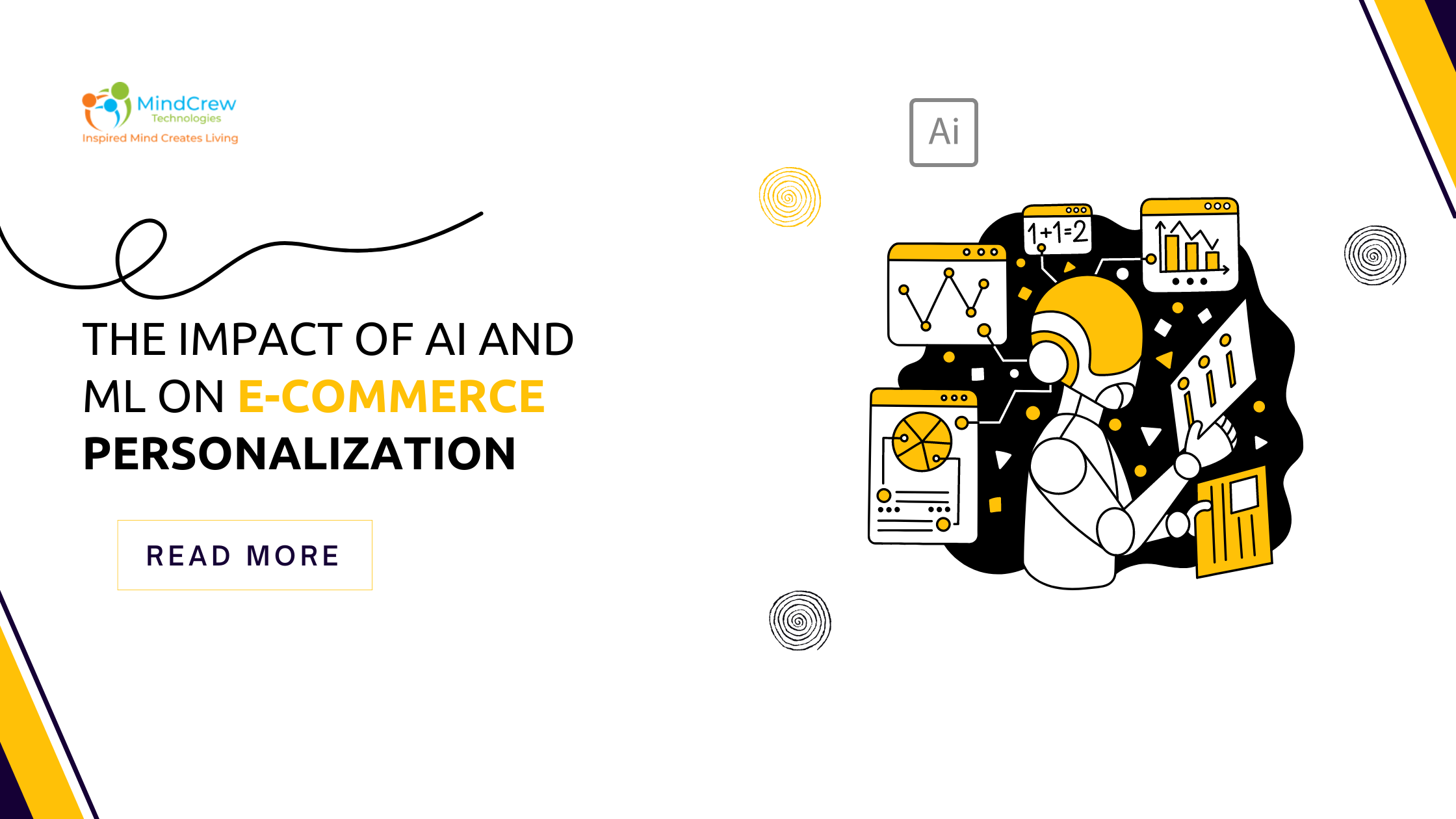The Impact of AI and ML on E-commerce Personalization
Introduction
In today’s digital age, e-commerce has become a cornerstone of the global economy, driving billions of dollars in transactions daily. As the e-commerce landscape continues to evolve, businesses are increasingly leveraging Artificial Intelligence (AI) and Machine Learning (ML) to enhance customer experience through personalization. E-commerce personalization, driven by AI and ML, has shifted from being a luxury to a necessity, enabling businesses to meet customer expectations, drive sales, and build brand loyalty.
The Rise of Personalization in E-commerce
Personalization in e-commerce refers to the process of tailoring the shopping experience to individual customers based on their preferences, behaviors, and past interactions. This could involve recommending products, customizing content, or altering the user interface to suit a particular user’s tastes. With the advent of AI and ML, personalization has moved beyond basic recommendation engines to become a sophisticated, dynamic, and highly effective strategy.
The Role of AI and ML in Personalization
- Data Collection and Analysis
- Understanding Customer Behavior: AI and ML algorithms can analyze vast amounts of data in real-time, including browsing history, purchase history, search queries, and even social media interactions. This data provides deep insights into customer preferences, enabling businesses to predict what customers are likely to buy next.
- Predictive Analytics: Machine learning models can forecast future trends and customer behaviors based on historical data. For example, if a customer frequently buys a particular brand of sneakers, an ML algorithm can predict when they might need a new pair and recommend similar products.
- Personalized Recommendations
- Collaborative Filtering: This is one of the most common AI-driven techniques used in e-commerce. Collaborative filtering algorithms analyze user behavior across a platform to recommend products that similar users have purchased or shown interest in.
- Content-Based Filtering: AI and ML can also tailor recommendations based on the characteristics of the products a customer has previously interacted with. For instance, if a customer likes a certain type of product, the system can recommend other products with similar attributes.
- Hybrid Models: Modern e-commerce platforms often use a combination of collaborative and content-based filtering to enhance the accuracy of recommendations, ensuring that customers are presented with the most relevant products.
- Dynamic Pricing
- Real-Time Adjustments: AI and ML enable dynamic pricing strategies, where the price of a product can be adjusted in real-time based on various factors such as demand, competition, customer behavior, and inventory levels. This allows businesses to optimize their pricing strategy to maximize revenue while still offering competitive prices.
- Customer-Specific Pricing: AI can personalize pricing at an individual level, offering discounts or promotions to specific customers based on their purchase history or likelihood to convert. This can significantly increase conversion rates and customer satisfaction.
- Personalized Content and Marketing
- Email Campaigns: AI and ML can optimize email marketing by analyzing customer data to send personalized emails. These emails can include product recommendations, special offers, or content that aligns with the recipient’s interests, leading to higher open and click-through rates.
- Ad Targeting: Machine learning algorithms can analyze customer data to create highly targeted ad campaigns. By identifying the most relevant audiences and predicting which ads they are likely to respond to, businesses can increase the effectiveness of their marketing efforts while reducing costs.
- Enhanced Customer Support
- AI-Powered Chatbots: Chatbots driven by AI can provide personalized customer support by understanding and responding to customer inquiries in real-time. These bots can offer product recommendations, assist with order tracking, and resolve issues without human intervention, all while personalizing the interaction based on the customer’s previous interactions with the brand.
- Sentiment Analysis: AI and ML can analyze customer feedback and social media interactions to gauge sentiment. This helps businesses identify potential issues, address customer concerns promptly, and improve overall customer satisfaction.
- Search Personalization
- Smart Search Algorithms: AI-driven search engines in e-commerce platforms can personalize search results based on user behavior. For example, if a customer frequently searches for a specific brand, the search engine can prioritize that brand in future searches.
- Voice and Visual Search: AI and ML have enabled the rise of voice and visual search capabilities. These technologies allow customers to search for products using voice commands or images, making the shopping experience more intuitive and personalized.
- Inventory Management and Supply Chain Optimization
- Demand Forecasting: Machine learning algorithms can analyze historical sales data, market trends, and external factors to forecast demand for specific products. This helps businesses manage inventory more effectively, reducing the risk of overstocking or stockouts.
- Supply Chain Efficiency: AI can optimize supply chain operations by predicting potential disruptions and suggesting alternative routes or suppliers. This ensures that products are always available when customers want them, improving the overall shopping experience.
The Benefits of AI and ML in E-commerce Personalization
- Improved Customer Experience
- Personalization creates a more engaging and satisfying shopping experience. When customers feel that a brand understands their needs and preferences, they are more likely to make a purchase and remain loyal to the brand.
- Increased Sales and Revenue
- By offering personalized recommendations, dynamic pricing, and targeted marketing, businesses can significantly increase their conversion rates. Personalized experiences drive customers to spend more, boosting overall revenue.
- Enhanced Customer Loyalty
- Personalized interactions build trust and loyalty. When customers receive recommendations and offers that align with their preferences, they are more likely to return to the brand for future purchases.
- Better Inventory Management
- AI and ML enable more accurate demand forecasting, leading to better inventory management. This reduces costs associated with overstocking or stockouts and ensures that customers can always find the products they want.
- Efficient Marketing Spend
- By targeting the right customers with the right messages, businesses can reduce their marketing spend while increasing the effectiveness of their campaigns. AI-driven personalization ensures that marketing budgets are used more efficiently.
Challenges of Implementing AI and ML in E-commerce Personalization
- Data Privacy Concerns
- Collecting and analyzing customer data for personalization raises privacy concerns. Businesses must ensure that they are transparent about how they use customer data and comply with data protection regulations such as GDPR.
- Integration with Existing Systems
- Implementing AI and ML solutions requires integrating them with existing e-commerce platforms and systems. This can be a complex process, requiring significant time and resources.
- Cost and Resource Requirements
- Developing and maintaining AI-driven personalization systems can be costly. It requires investment in technology, data infrastructure, and skilled personnel to manage and optimize these systems.
- Maintaining Relevance
- As AI and ML systems learn from customer data, there is a risk of becoming too focused on past behavior, leading to recommendations that may not be relevant to a customer’s current needs or interests. Businesses must continuously update and refine their algorithms to maintain relevance.
Future Trends in AI and ML-Driven E-commerce Personalization
- Hyper-Personalization
- The future of e-commerce personalization lies in hyper-personalization, where AI and ML will enable businesses to deliver even more precise and individualized experiences. This could include real-time personalization based on a customer’s current context, such as their location or the time of day.
- AI-Driven Virtual Shopping Assistants
- As AI technology advances, we can expect the rise of virtual shopping assistants that use natural language processing and machine learning to provide highly personalized shopping experiences. These assistants could help customers find products, offer style advice, or even complete purchases on their behalf.
- Augmented Reality (AR) and Virtual Reality (VR) Integration
- AI and ML will play a key role in integrating AR and VR into e-commerce. These technologies will allow customers to virtually try on products, explore virtual stores, and receive personalized recommendations based on their interactions in these virtual environments.
- Ethical AI and Personalization
- As AI and ML become more prevalent in e-commerce, there will be a growing focus on ethical AI. This includes ensuring that personalization algorithms are fair, transparent, and do not perpetuate biases. Businesses will need to consider the ethical implications of their AI-driven personalization strategies to maintain customer trust.
Conclusion
The impact of AI and ML on e-commerce personalization is profound, transforming the way businesses interact with customers. By leveraging these technologies, businesses can offer personalized experiences that drive sales, enhance customer loyalty, and optimize operations. However, to fully realize the benefits of AI and ML in e-commerce, businesses must address challenges such as data privacy, integration, and ethical considerations. As technology continues to evolve, the future of e-commerce personalization promises to be even more dynamic, with hyper-personalization, virtual shopping assistants, and AR/VR integration leading the way.







